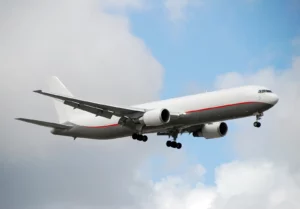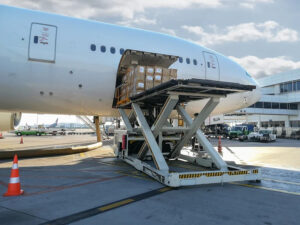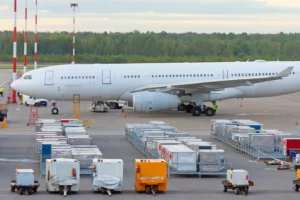
Strong demand and tight capacity push rates up as air cargo market defies predictions
Global air freight rates rose in November according to the latest data from TAC Index – with a number of seasonal factors, longer term trends and short term events conspiring to drive prices higher. The overall Baltic Air Freight Index (BAI00) calculated by TAC rose +6.0% over the four weeks to December 1, leaving it a little lower – though by only -3.3% – from where it was at the same time last year. Longer-term factors driving up rates include capacity constraints due to production delays and a shortage of new feedstock to convert into dedicated cargo freighters – with many existing freighters reaching advanced age and needing replacement. This problem was highlighted dramatically in November by the fatal crash of a UPS cargo plane in Louisville, Kentucky – resulting in the whole fleet of aging MD-11 freighters being grounded for safety checks. Although the MD-11s – operated by FedEx and Western Global as well as UPS – represent a fairly modest proportion of total market capacity, their grounding came at a tricky time when the market traditionally enters peak season and capacity is stretched. This year’s story of on-off trade wars – with new trade barriers and higher tariffs particularly between China and the US – had led some to expect there may not be much of a peak season this year. However, evidence so far suggests that although direct bilateral trade between the US and China may have fallen, overall volume levels have not been affected – with Asia-Europe and intra-Asia activity rising sharply as well as to and from the Middle East and Africa, according to the latest air cargo volume statistics from IATA. Despite an end to the de minimis exemption for small packages and higher tariffs, US imports do not seem much changed either – if arriving via different places. The latest data on air cargo rates appear to show the first stage of peak season – ahead of Thanksgiving in the US – went very much as usual. And with every prospect that the second stage – ahead of Christmas in Europe – would continue in the traditional pattern. BAI Spot rates out of Hong Kong certainly rose strongly through the month. HK to US East Coast spot rates were already spiking in October and rose further from HK$44.46 per kilo on October 31 to HK$54.04 by December 1. HK to US West Coast surged from HK$41.36 to HK$51.32 over the same period. Meanwhile, HK to Europe spot rates jumped from HK$37.91 per kilo on October 31 to HK$48.03 by December 1. The overall index of outbound routes from Hong Kong (BAI30) – reflecting the full spectrum of spot and forward contract rates on all routes being paid – gained a more modest +7.8% over the four weeks to December 1, leaving it slightly lower at -3.4% YoY. However, that underlying jump in spot rates probably points towards a further surge in the overall index over the remaining three weeks until Christmas – as occurred in both the previous two years. Meanwhile, the outbound index for Shanghai (BAI80) gained +6.6% month-on-month – to leave it ahead by +2.4% year-on-year. Rates from other regions were more mixed. Out of Europe, the index of outbound routes from Frankfurt (BAI20) dipped -8.6% MoM – to leave it languishing at -17.0% YoY. By contrast, outbound London Heathrow (BAI40) surged +21.8% MoM to push it ahead by +7.1% YoY. From the Americas, the index of outbound routes from Chicago (BAI50) gained a more modest +2.4% MoM – to leave it still languishing at – 17.1% YoY. However, the latest numbers were also showing some significant gains on rates for various other lanes added to the data set in recent months by TAC – including from Taiwan and Seoul in North Asia, and from Bangkok and Vietnam in South East Asia. So far at least, the evidence suggests that this year’s turbulent geopolitical developments and severe trade tensions do not appear to have hit overall volumes or rates much – though the patterns of trade may have shifted significantly. With crude oil prices down by 20% or more over the past year, one might also think the robust market might be translating into surging profits too for air cargo carriers. However, a tightening diesel market has also been driving the ‘crack spread’ wider to nearly double last year’s level – and keeping jet fuel prices up, according to the latest figures from Platts. ‘Goldilocks’ – or the three bears? Meanwhile, from a macro perspective investors were focusing on two potential ways markets may develop going forward. One: whether there would be a continuing ‘Goldilocks’ outcome – where easing inflation, falling interest rates and further fiscal stimulus will help ease the global economy through a relatively pain-free slowdown. Or two: whether the bears will prove right for one of three potential reasons – that the boom in AI becomes a bubble that bursts; that labour market weakness might lead to a more serious downturn; and/or whether sovereign debt problems will de-rail economic growth and lead to recession. On the AI side, markets suffered another bout of selling in mid-late November before rebounding again – though remaining nervous about the sheer scale of investment getting concentrated in the sector. Bitcoin and other cryptocurrency assets also plummeted sharply last month by 30% and more from their October highs. On the labour market side, markets were fretting in part about a potential rise in lay-offs caused by the adoption of AI – though figures on that remain mixed so far. On sovereign debt, worries were continuing about the sustainability of mounting debt levels in various major economies – notably France and the UK. However, most players continue to view this as a chronic problem – not yet a critical one – with continuing ‘wiggle room’ for governments and central banks to navigate. In the short term at least, air freight markets seem unperturbed.









